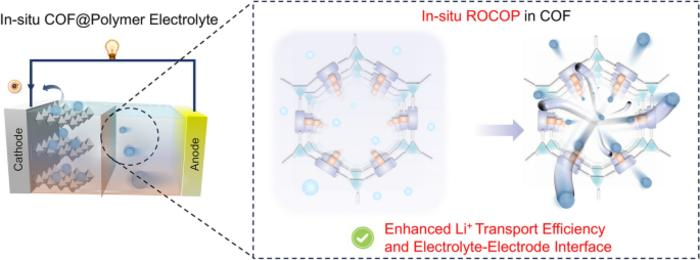Boosting Lithium Metal Batteries: Solid Polymer Electrolytes Enhanced with Covalent Organic Frameworks

As the demand for high-performance and sustainable energy storage grows, scientists are intensifying efforts to improve solid polymer electrolytes (SPEs) for lithium metal batteries (LMBs). A new study led by Professors Xingping Zhou and Zhigang Xue from Huazhong University of Science and Technology presents a novel strategy to enhance lithium-ion conduction by combining SPEs with covalent organic frameworks (COFs).
Their approach utilizes in situ polymerization within COFs, forming a robust structure with enhanced ion transport pathways. This breakthrough promises safer, higher-performing LMBs and opens the door for their use in next-generation energy storage systems.
Why Solid Polymer Electrolytes?
Traditional SPEs are limited by poor ionic conductivity and low lithium-ion transference numbers, which restrict their application in high-performance batteries. The integration of COFs addresses these challenges by providing ordered ion transport channels and customizable functional sites. In this study, the team used the anionic COF TpPa-COOLi to accelerate ring-opening copolymerization (ROCOP) of cyclic lactone monomers, enabling the in situ formation of SPEs with improved performance.
Key Benefits of the New Approach
- Improved Ion Transport Efficiency: The COF structure enhances lithium-ion mobility, resulting in higher ionic conductivity and transference numbers.
- Better Electrode–Electrolyte Interface: In situ polymerization ensures uniform COF distribution in the polymer matrix, reducing interfacial resistance and improving cycling stability.
- Suitability for High-Voltage Applications: The SPEs demonstrated excellent stability and performance with high-voltage cathodes, a key requirement for advanced batteries.
Advanced Computational Insights
Using density functional theory (DFT) and molecular dynamics simulations, the researchers explored lithium-ion migration mechanisms. They found that in situ polymerization strengthens the interaction between lithium ions and the polymer, facilitating more efficient ion transport.
Performance and Applications
The SPEs developed in this study achieved notable electrochemical performance. At room temperature, they exhibited an ionic conductivity of 1.1 × 10⁻⁵ S cm⁻¹ and a lithium-ion transference number of 0.85. In Li//LFP half-cells, they demonstrated a high initial capacity of 157.9 mAh g⁻¹ and retained 76% capacity after 1000 cycles. For high-voltage systems, the SPEs showed oxidation stability up to 5.0 V, achieving promising results with NCM622 cathodes.
“This innovative method not only boosts conductivity but also ensures long-term cycling stability, addressing key challenges in lithium metal batteries,” said Professor Zhou.
Looking Forward
The researchers aim to simplify COF synthesis and address scalability challenges in future studies. The in situ polymerization technique also shows potential for adaptation to other battery chemistries, further broadening its impact on the energy storage industry.
Read the full article on AZoM here: New Method Boosts Lithium-Ion Conduction in Solid Polymer Electrolytes.
Sponsored by PWmat (Lonxun Quantum) – a leading developer of GPU-accelerated materials simulation software for cutting-edge quantum, energy, and semiconductor research. Learn more about our solutions at: https://www.pwmat.com/en
📘 Download our latest company brochure to explore our software features, capabilities, and success stories: PWmat PDF Brochure
📞 Phone: +86 400-618-6006
📧 Email: support@pwmat.com
Hashtags: #LithiumMetalBatteries #SolidPolymerElectrolytes #EnergyStorage #COF #BatteryInnovation #QuantumServerNetworks #PWmat

Comments
Post a Comment